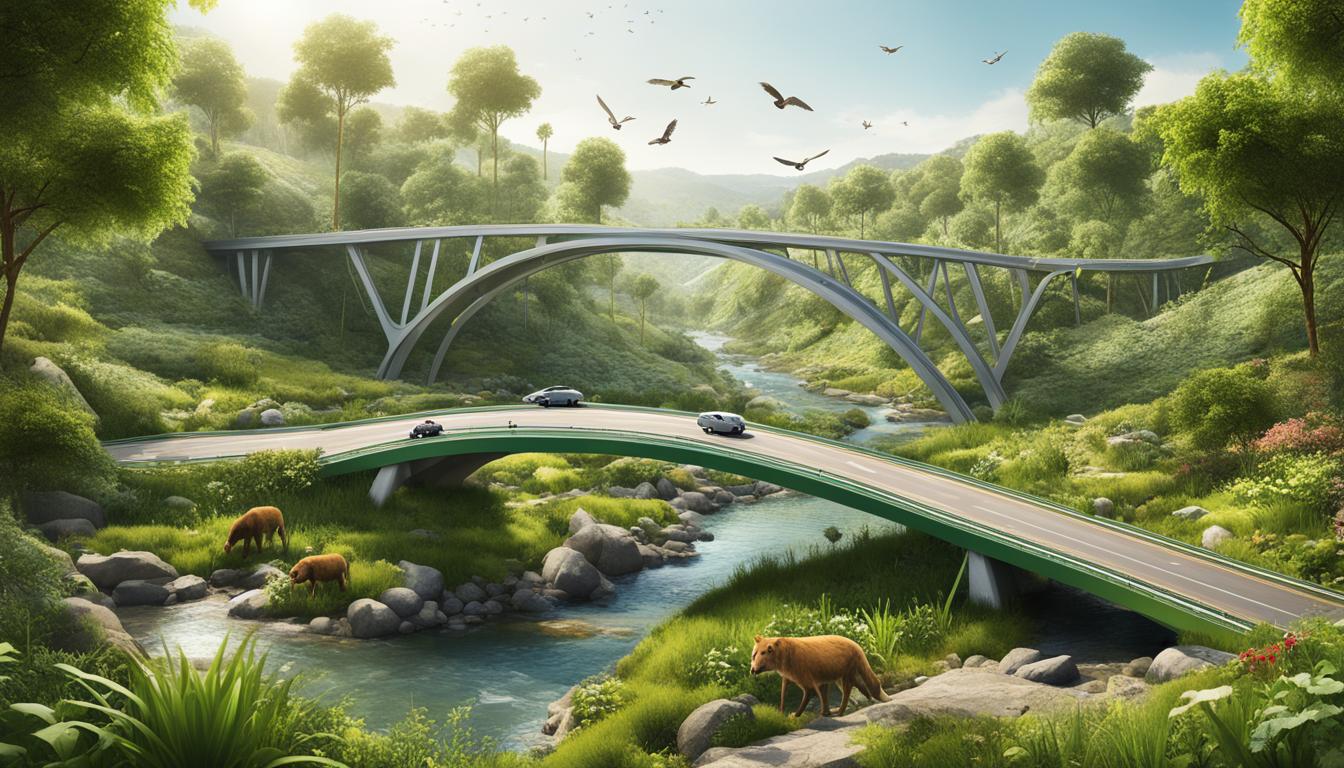
As cities continue to expand rapidly, the need for innovative architectural solutions that prioritize biodiversity connectivity becomes increasingly important. Urban ecosystems are expanding at an alarming rate, posing a threat to wildlife populations living in and around cities. The loss of natural habitat and fragmentation of existing habitats due to urban expansion can lead to isolated populations, reduced genetic diversity, and an increase in human-wildlife conflicts.
To address these challenges, architects and urban planners are exploring new approaches to create habitat connectivity and promote sustainable urban development. From wildlife corridors and green infrastructure to wildlife-friendly and eco-friendly building designs, these architectural solutions offer a fresh perspective on urban planning.
One such example is the story of the city of Bristol in the United Kingdom. Facing the dilemma of urban expansion endangering local wildlife, the city collaborated with architects, conservationists, and community stakeholders to create a network of wildlife corridors and green spaces throughout the city. This innovative approach not only provided safe passage for wildlife, but it also rejuvenated the urban landscape, making green spaces accessible to residents and improving their quality of life.
By integrating these architectural solutions into urban planning, cities can ensure that wildlife populations can thrive in their natural habitats while coexisting harmoniously with human inhabitants. The importance of preserving biodiversity and creating meaningful connections between urban environments and nature cannot be overstated.
Key Takeaways:
- Architectural solutions for biodiversity connectivity can address challenges posed by urban expansion and promote sustainable urban development.
- Wildlife corridors, green infrastructure, and wildlife-friendly building design are effective approaches to enhance habitat connectivity and mitigate human-wildlife conflicts.
- Eco-friendly architectural design and sustainable urban planning support biodiversity preservation and create vibrant and livable urban landscapes.
- Collaboration between architects, conservationists, and community stakeholders is crucial for the successful implementation of architectural solutions for biodiversity connectivity.
- Creating a balance between urban development and nature conservation is essential for building resilient and biodiverse cities.
The Importance of Urban Wildlife Conservation
Urban wildlife conservation plays a vital role in safeguarding both the wildlife and human inhabitants of cities. By managing urban wildlife populations, we can contribute to the conservation of species and mitigate the occurrence of human-wildlife conflicts. Additionally, fostering positive human-wildlife interactions brings psychological benefits and encourages engagement with conservation efforts.
However, the loss of wildlife from cities can disrupt the virtuous cycle between biodiversity conservation and human inhabitants. As urban expansion continues, it disproportionately impacts low-income communities and communities of color, exacerbating environmental inequities. To address these challenges, successful strategies for urban wildlife conservation must strengthen the virtuous cycle and promote biodiversity in urban areas.
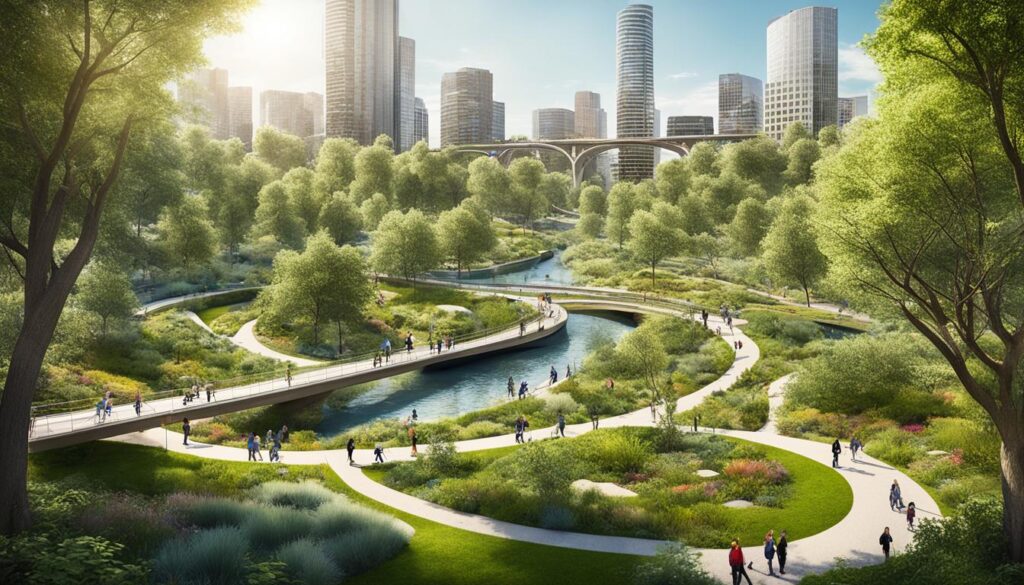
By prioritizing urban wildlife conservation, we can create sustainable and biodiverse urban environments where humans and wildlife coexist harmoniously. This integration positively impacts the quality of life for urban residents and ensures the long-term survival of diverse species.
Wildlife Corridors as a Solution for Biodiversity Connectivity
Wildlife corridors play a crucial role in enhancing biodiversity connectivity and addressing the challenges of habitat fragmentation, population isolation, and genetic admixture. As human activities continue to fragment natural habitats, wildlife populations become increasingly isolated, leading to reduced genetic diversity and heightened vulnerability to environmental changes. However, the implementation of wildlife corridors can offer a lifeline to these isolated populations.
By providing a continuous pathway for wildlife movement, wildlife corridors enable species to traverse fragmented landscapes, reconnecting isolated populations and promoting genetic admixture. This interconnectedness is essential for maintaining healthy populations and adapting to changing climates, ensuring the long-term survival of species.
Additionally, wildlife corridors have the potential to mitigate human-wildlife conflicts, such as vehicle-wildlife collisions. By guiding wildlife away from high-traffic areas and providing alternative paths, these corridors reduce the risk of accidents and promote coexistence between humans and wildlife.
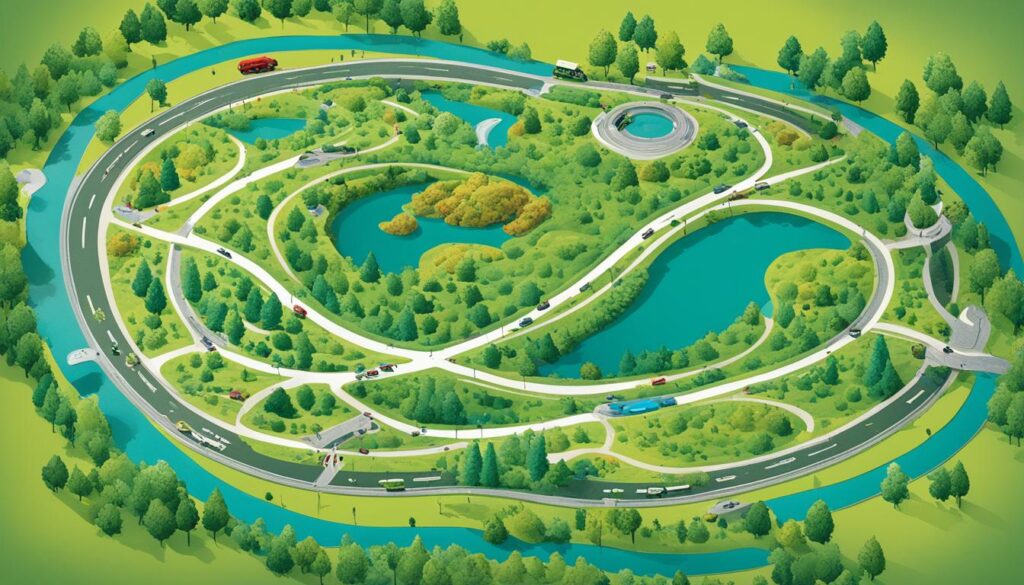
In the words of renowned biologist E.O. Wilson: “The creation of wildlife corridors is a prerequisite to maintaining biodiversity.” Wildlife corridors act as ecological bridges, connecting fragmented habitats and allowing species to disperse, forage, and find mates. They are essential for preserving the intricate web of life that sustains our planet.
Investing in the establishment and maintenance of wildlife corridors is not only crucial for the conservation of biodiversity but also for preserving the planet’s ecological balance. As urban areas continue to expand, these corridors become increasingly vital, offering a lifeline for wildlife amidst human-dominated landscapes.
Challenges of Implementing Wildlife Corridors in Urban Areas
Implementing wildlife corridors in urban areas poses unique challenges due to factors such as habitat fragmentation, changing land ownership and usage, disciplinary silos, and urban sprawl. These challenges must be addressed to ensure effective urban wildlife conservation and promote biodiversity connectivity.
Habitat Fragmentation
Urban areas experience more complex habitat fragmentation compared to rural locations. In cities, habitat patches are often separated by multiple roads, buildings, and other anthropogenic barriers. This fragmentation restricts wildlife movement and limits access to necessary resources.
Land Ownership and Usage
Land ownership and usage within cities can change rapidly, making it challenging to implement traditional corridor design recommendations. Cooperation and coordination among various stakeholders, including government agencies, private landowners, and developers, are crucial to ensure the continuity and effectiveness of wildlife corridors.
Disciplinary Silos
In urban conservation planning, disciplinary silos can hinder effective collaboration and coordination between environmental planners, architects, engineers, and policymakers. Breaking down these silos and fostering interdisciplinary approaches will facilitate the integration of wildlife corridors into urban development plans.
Urban Sprawl
The expansion of cities through urban sprawl further complicates the implementation of wildlife corridors. Rapid development and increased infrastructure can fragment habitats, disrupt existing wildlife populations, and create barriers to movement. Conserving urban wildlife corridors requires careful consideration of the potential impact of urban sprawl.
Conservation Planning
Effective conservation planning in urban areas involves balancing the needs of people and wildlife. This requires considering the social, economic, and environmental aspects of urban development. Collaboration among urban planners, conservationists, community groups, and policymakers is essential to develop comprehensive strategies that address these competing interests.
“Urban wildlife conservation faces complex challenges in implementing wildlife corridors due to habitat fragmentation, changing land ownership, disciplinary silos, urban sprawl, and the need for comprehensive conservation planning.”
Overcoming these challenges necessitates a unifying framework that bridges efforts across jurisdictions and stakeholders. Collaboration between researchers, planners, policymakers, and communities is vital to develop innovative strategies and integrated approaches for successful urban wildlife conservation.
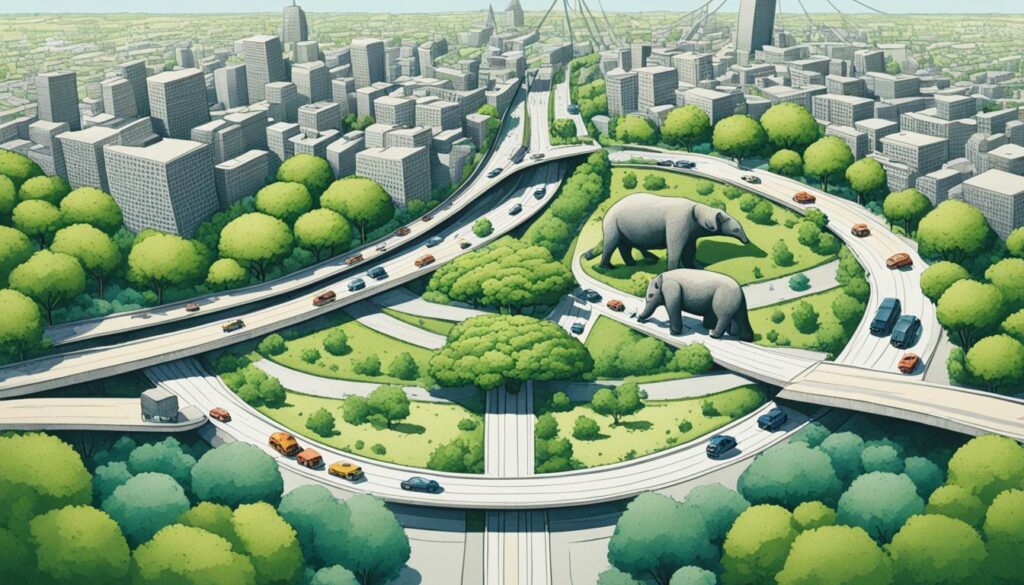
Strategies for Urban Wildlife Corridor Conservation
To conserve urban wildlife corridors and enhance biodiversity connectivity in urban areas, various strategies can be implemented. These strategies aim to create and maintain habitats, facilitate wildlife movement, and protect critical habitat patches. By combining these approaches, cities can foster urban wildlife conservation and promote sustainable urban development.
1. Green Infrastructure
Green infrastructure plays a vital role in urban wildlife corridor conservation. By creating green spaces, parks, and urban forests, cities can provide habitats for diverse wildlife species. These green areas act as stepping stones and pathways, facilitating wildlife movement and promoting gene flow between populations. Additionally, green infrastructure helps mitigate the adverse effects of urbanization, such as habitat fragmentation and loss.
2. Backyard Habitat Restoration
Engaging residents in backyard habitat restoration projects is another effective strategy. Encouraging individuals to create wildlife-friendly spaces in their own properties not only enhances urban biodiversity but also fosters a sense of ownership and connection to nature. By providing resources such as native plants, bird feeders, and water sources, homeowners can create havens for local wildlife, contributing to the overall connectivity of urban wildlife corridors.
3. Land Acquisitions
Acquiring and protecting important habitat patches is crucial for maintaining urban wildlife corridors. Cities can invest in land acquisitions to secure and preserve critical areas that serve as wildlife passages. These acquisitions can include private lands, vacant lots, or undeveloped areas within the urban landscape. By strategically protecting these habitats, cities can ensure the continuity and integrity of urban wildlife corridors.
4. Conservation Partnerships
Collaboration with various stakeholders is essential for successful urban wildlife corridor conservation. Conservation partnerships bring together government agencies, non-profit organizations, community groups, and individual citizens to work towards a shared goal of enhancing biodiversity connectivity. These partnerships can involve joint planning, fundraising, educational campaigns, and implementation of conservation initiatives. By combining resources and expertise, conservation partnerships can achieve more significant conservation outcomes than individual efforts.
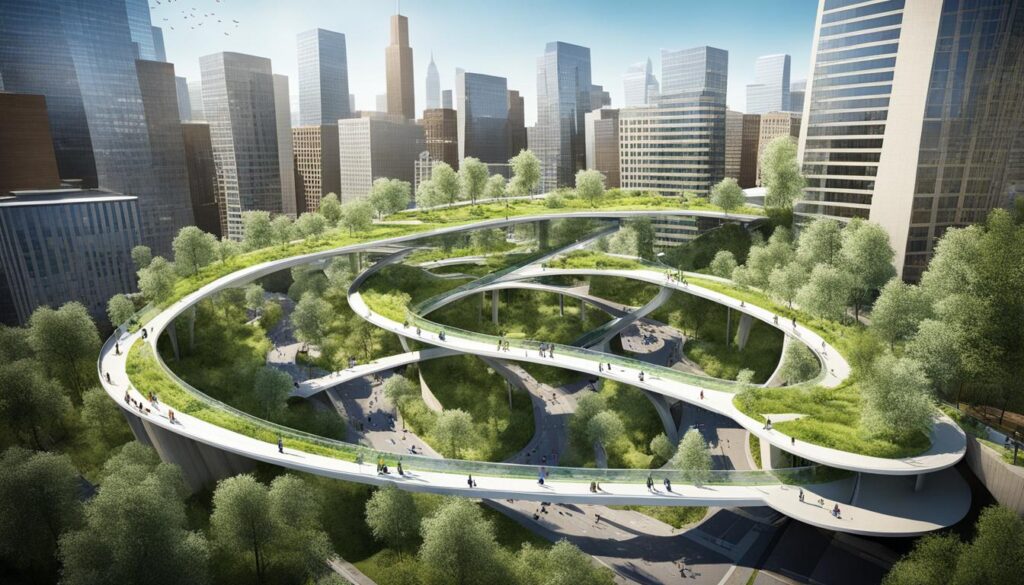
With a comprehensive approach that integrates green infrastructure, backyard habitat restoration, land acquisitions, and conservation partnerships, cities can strengthen biodiversity connectivity and build bridges between diverse stakeholders. Implementing these strategies not only benefits urban wildlife but also enhances the quality of life for residents, promoting a harmonious coexistence between humans and nature in urban environments.
Preserving Biodiversity in Building Design
Preserving biodiversity in building design is essential to minimize the impact on natural habitats and support the local wildlife. By understanding the existing species on the selected site and their life cycles through site analysis, architects and developers can plan construction projects to avoid endangering critical species.
Building design should aim to reduce pollution throughout the entire building lifecycle, including planning, construction, and operations. This not only benefits the environment but also creates healthier and more sustainable buildings.
Strategies for preserving biodiversity in building design include:
- Incorporating green infrastructure: This involves integrating natural elements, such as green roofs, living walls, and rain gardens, into the building design to provide habitat and promote biodiversity.
- Using pervious concrete: Pervious concrete allows water to infiltrate the ground, reducing stormwater runoff and preserving natural drainage systems. It also helps prevent soil erosion and allows for better water filtration, supporting healthy ecosystems.
- Implementing xeriscaping with native plants: Xeriscaping is a landscaping technique that focuses on water conservation by using drought-resistant plants. By incorporating native plant species into building design, biodiversity can be preserved, damaged habitats can be restored, and new ecosystems can be created.
“Preserving biodiversity in building design not only benefits the environment but also creates healthier and more sustainable buildings.”
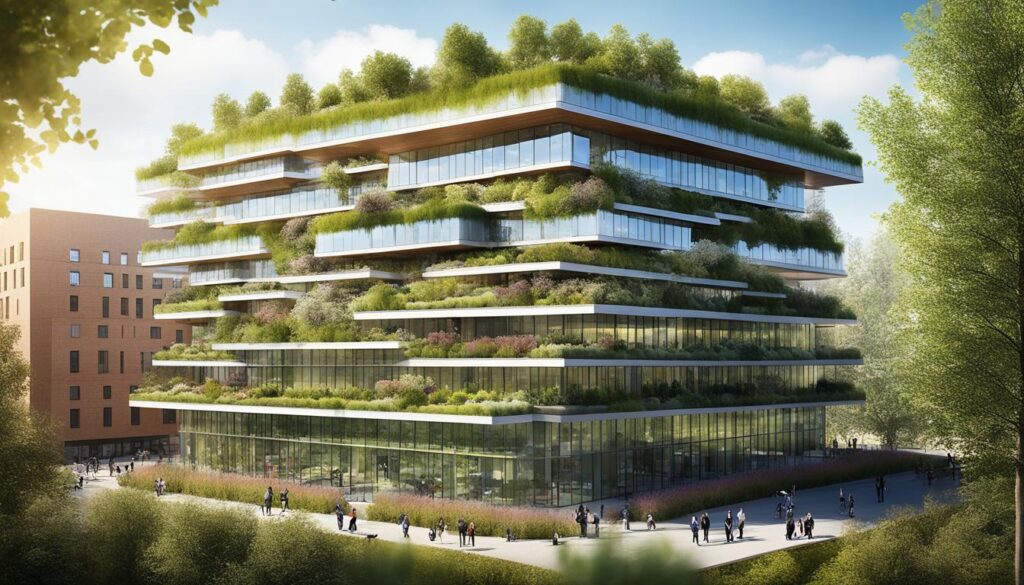
Strategies for Preserving Biodiversity in Building Design
| Strategy | Description |
|---|---|
| Incorporating green infrastructure | Integrating natural elements into the building design to provide habitat and promote biodiversity. |
| Using pervious concrete | Allowing water to infiltrate the ground, reducing stormwater runoff and preserving natural drainage systems. |
| Implementing xeriscaping with native plants | Using drought-resistant native plant species to conserve water and support biodiversity. |
By adopting these strategies, architects and developers can help preserve biodiversity, restore damaged habitats, and create sustainable building designs that have a positive impact on the environment and local wildlife.
The Role of Green Roofs in Supporting Biodiversity
Green roofs have emerged as a sustainable building design solution that not only provides numerous environmental benefits but also plays a vital role in supporting biodiversity. Categorized as extensive, semi-intensive, and intensive, green roofs offer habitats for native plants, insects, and small animals, contributing to the overall biodiversity of urban areas.
One of the key advantages of green roofs is their ability to accommodate native plant species that are well-suited to the local climate. These native plants require minimal additional water, making them ideal for sustainable building design. By incorporating native vegetation into green roofs, urban areas can create microhabitats that support local biodiversity, promoting the survival of native species and their interactions within the ecosystem.
In contrast, it is crucial to avoid the use of invasive species in green roofs to protect the integrity of native ecosystems. Invasive species can outcompete native plants, disrupt ecological balances, and negatively impact wildlife populations. By selecting appropriate plant species for green roof installations and avoiding invasive plants, the potential risks of introducing non-native species can be minimized, ensuring the preservation of local biodiversity.
Furthermore, the incorporation of green roofs into buildings can help mitigate the loss of natural habitats caused by increased construction in urban areas. As cities expand and green spaces diminish, green roofs provide a means of recreating lost habitats, allowing flora and fauna to thrive where they otherwise would not. This supports biodiversity by providing additional resources for local wildlife and promoting ecological connectivity throughout urban landscapes.
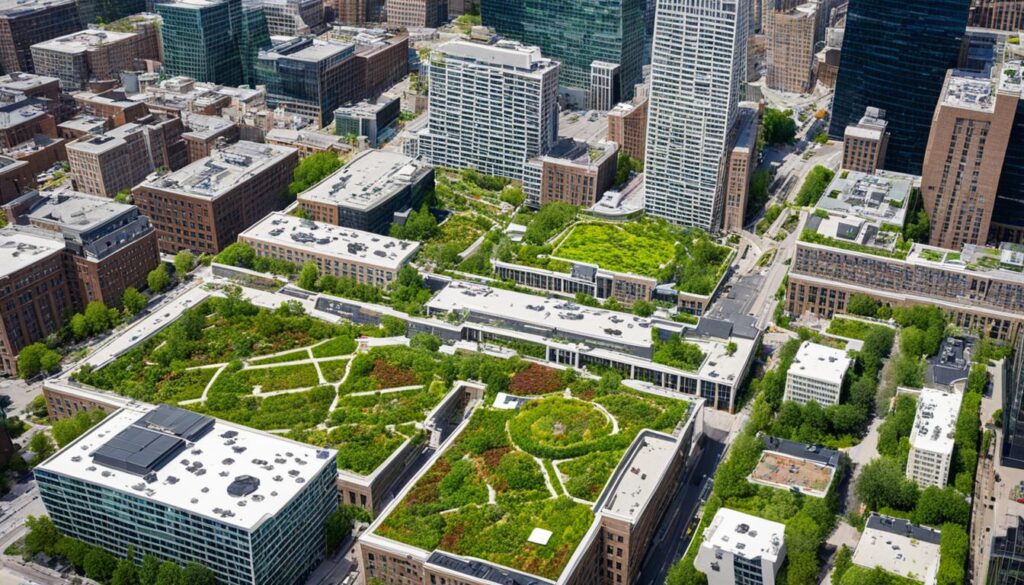
Green roofs offer not only direct benefits to biodiversity but also indirect environmental advantages. They assist in managing stormwater by reducing runoff, helping to prevent flooding and maintaining the quality of water bodies. Additionally, green roofs contribute to energy efficiency by insulating buildings, reducing the urban heat island effect, and mitigating climate change impacts.
In summary, green roofs play a significant role in sustainable building design and biodiversity conservation. By supporting native plant species, avoiding invasive plants, and recreating lost habitats, green roofs contribute to the preservation of biodiversity in urban areas. Incorporating green roofs into building projects not only enhances the visual appeal of cities but also fosters a healthier and more sustainable coexistence between humans and nature.
Incorporating Nature-Based Solutions in Green Building Practices
Nature-based solutions offer promising opportunities for integrating sustainability into green building practices, with a particular focus on biodiversity preservation and promoting sustainable sites. By prioritizing the protection and restoration of habitats, green building projects can contribute to the overall health and resilience of ecosystems.
“Nature provides us with invaluable resources and services. It is our responsibility to incorporate these solutions into our built environment to ensure a harmonious coexistence between human activities and the natural world.”
Benefits of Nature-Based Solutions in Green Building Practices
Integrating nature-based solutions into green building practices brings numerous benefits, including:
- Promoting biodiversity preservation by creating habitats and supporting the growth of native plant and animal species.
- Enhancing the aesthetic appeal of buildings and surrounding areas by incorporating green spaces, living walls, and rooftop gardens.
- Improving air quality and reducing pollution through the filtration capabilities of vegetation and natural materials.
- Providing natural shading and cooling effects, reducing the need for energy-intensive cooling systems.
- Managing stormwater runoff and reducing the risk of flooding by incorporating green infrastructure, such as rain gardens and permeable pavements.
LEED Credits for Nature-Based Solutions
The Leadership in Energy and Environmental Design (LEED) certification system recognizes and rewards green building projects that prioritize sustainability and environmental stewardship. The incorporation of nature-based solutions in design and construction can help earn LEED credits, showcasing a commitment to biodiversity preservation and sustainable development.
Here is an overview of LEED credits that can be achieved through the implementation of nature-based solutions:
| LEED Credit Category | Related Nature-Based Solutions |
|---|---|
| Sustainable Sites | Protecting and restoring natural habitats, implementing green roofs and walls, utilizing permeable surfaces |
| Water Efficiency | Implementing stormwater management systems, utilizing rainwater harvesting |
| Energy and Atmosphere | Reducing energy consumption through natural shading and passive design strategies |
| Materials and Resources | Using sustainable and locally sourced materials with a low environmental impact |
| Innovation | Demonstrating innovative approaches to biodiversity preservation and sustainable site design |
By earning LEED credits in these categories, green building projects can showcase their commitment to sustainable design, construction, and operation, while fostering the protection and enhancement of biodiversity.
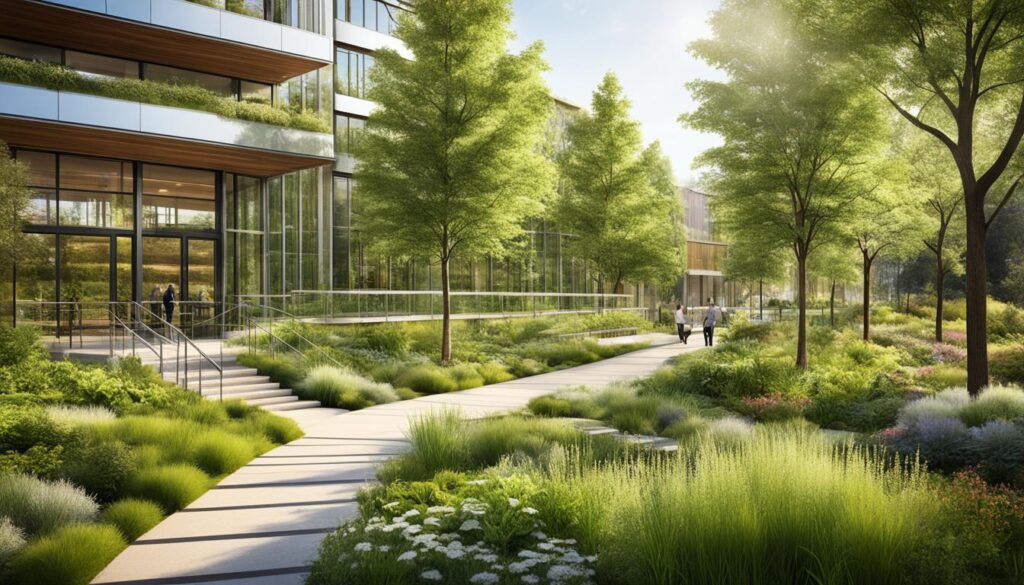
Incorporating nature-based solutions in green building practices is not only a responsible approach to construction but also an investment in a sustainable future. By prioritizing biodiversity preservation and utilizing sustainable sites, architects, developers, and building owners can create healthy, resilient, and environmentally-friendly buildings, contributing to the overall well-being of both human and natural communities.
Conclusion
Architectural solutions for biodiversity connectivity are vital for urban wildlife conservation and the promotion of biodiverse urban development. By implementing wildlife corridors, green infrastructure, and other strategies, cities can enhance biodiversity connectivity and address the threats posed by urban expansion. Preserving biodiversity in building design and incorporating nature-based solutions in green building practices play a crucial role in safeguarding ecosystems and supporting wildlife populations.
The importance of these architectural solutions cannot be overstated. They not only help create vibrant and sustainable urban landscapes but also bridge the gap between human inhabitants and the natural world. By embracing nature-based solutions, such as wildlife corridors and green roofs, cities can provide habitats, restore ecosystems, and minimize the negative impact of urbanization on wildlife and biodiversity.
With ongoing urbanization, it is essential for architects, developers, and city planners to prioritize these architectural solutions for biodiversity connectivity. By incorporating them into urban planning and design, we can create cities that not only thrive economically and socially but also prioritize the well-being of wildlife and the preservation of nature. Through collaborative efforts and a commitment to sustainable practices, we can build a future where urban areas coexist harmoniously with biodiversity, ensuring a greener and healthier planet for generations to come.
FAQ
What are architectural solutions for biodiversity connectivity?
Architectural solutions for biodiversity connectivity involve designing wildlife corridors and implementing green infrastructure, backyard habitat restoration, land acquisitions, and conservation partnerships to enhance movement and genetic admixture of wildlife populations.
Why is urban wildlife conservation important?
Urban wildlife conservation is crucial to protect species, prevent human-wildlife conflicts, and promote positive human-wildlife interactions. It also fosters biodiversity, which benefits both wildlife and human inhabitants of cities.
How do wildlife corridors enhance biodiversity connectivity?
Wildlife corridors connect isolated wildlife populations, promote genetic admixture, reduce the risk of inbreeding, and facilitate the movement of species between fragmented habitats, ensuring their long-term survival.
What challenges are involved in implementing wildlife corridors in urban areas?
Implementing wildlife corridors in urban areas is challenging due to fragmented habitat patches, multiple land ownerships, changing land usage, disciplinary silos, and the complex nature of habitat fragmentation and urban sprawl.
What strategies can be implemented for urban wildlife corridor conservation?
Strategies for urban wildlife corridor conservation include implementing green infrastructure, promoting backyard habitat restoration, facilitating land acquisitions, and fostering conservation partnerships to strengthen connectivity and collaboration among stakeholders.
How can biodiversity be preserved in building design?
Biodiversity can be preserved in building design by conducting site analysis, planning construction around critical species’ life-cycles, reducing pollution throughout the building lifecycle, and incorporating green infrastructure, pervious concrete, and native plant xeriscaping.
What is the role of green roofs in supporting biodiversity?
Green roofs provide habitats for native plants, insects, and small animals, support stormwater management, and restore lost habitats in urban areas. Incorporating green roofs into buildings helps preserve biodiversity and enhance sustainable building design.
How can nature-based solutions be incorporated in green building practices?
Nature-based solutions can be incorporated in green building practices by prioritizing habitat preservation and restoration, utilizing green roofs, integrating native plant species, and earning credits through building certifications like LEED.
What is the significance of architectural solutions for biodiversity connectivity?
Architectural solutions for biodiversity connectivity promote urban wildlife conservation, support biodiverse urban development, and bridge the gap between human inhabitants and the natural world, creating vibrant and sustainable urban landscapes.
